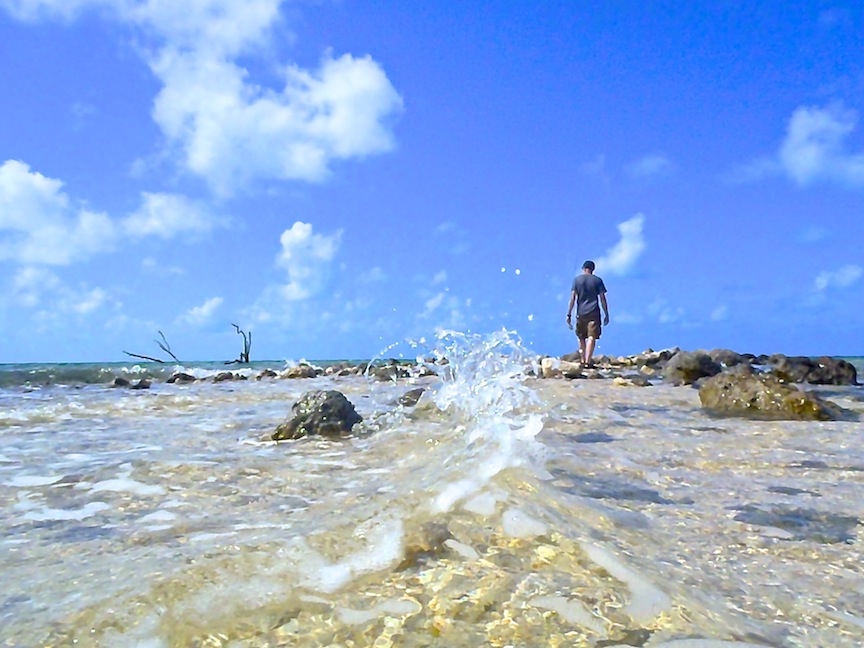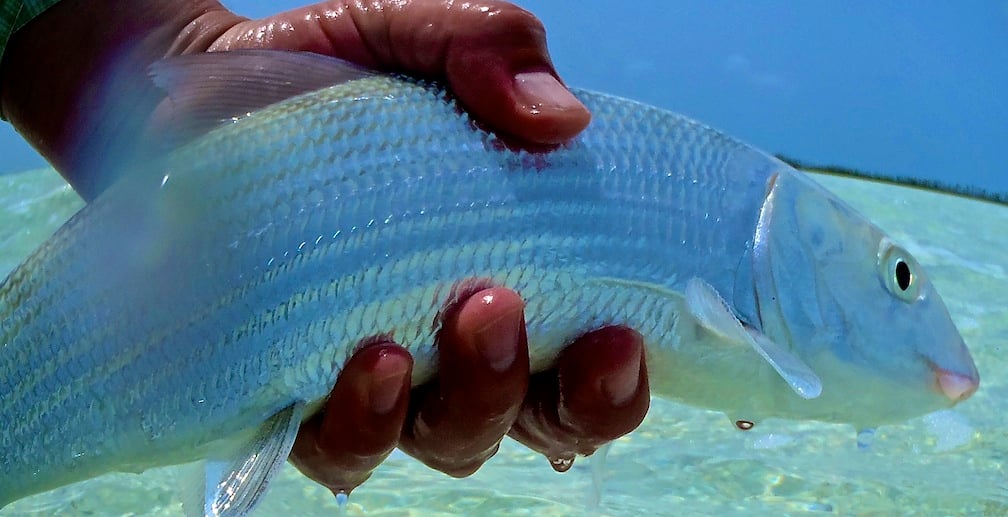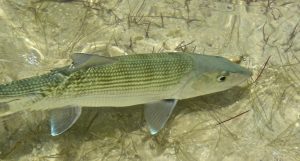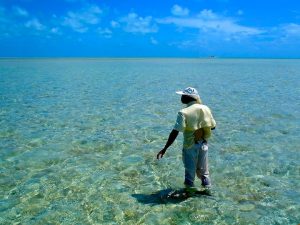Five Tips: Bahamas Bonefish on a Budget
Walking the flats of the southern Bahamas in high summer isn’t for the faint of heart, and unless you plan it just right, it’s not going to be easy on your bank account, no matter when you decide to chase bonefish. But by finding ways to do it yourself—or to do most of it yourself—you can save a pretty penny and experience the thrill of casting to and catching bones on the fly.
And that’s without the chatty guide pointing out every technique flaw or chewing you out because your fish-spotting is a bit rusty.
The downside is simple. Until you do it a few times and learn on the go, you’re not going to have the success you would if you paid for a guide to show you the ropes. The upside? You don’t have to pay for a guide, and, if you’re like me, the journey is almost as much fun as the destination.
But it’s still not cheap. Just the cost of the plane ticket alone makes me shudder, and if I didn’t have enough accumulated miles, I’d certainly stay home and wander up some remote trout stream rather than hop the red-eye from Phoenix to Newark and then catch a morning flight to Nassau.
Still, the chance to catch bonefish was enough to convince me fork over the miles for a recent trip to Deadman’s Cay—and miles are like currency to us wandering fly fishers. My actual savings account is virtually empty, but when my miles dwindle to where I can only envision a trip or two in the near future to some far-flung place to chase some new piscatorial wonder, I start to sweat a little bit.
And maybe that’s Tip No. 1. Buy the tickets you can afford to buy when you travel. You know, when you must fly from Seattle to Boston for a funeral, or if you’re headed to that Vegas bachelor party, find a way to pay for the trip. Save your miles up. You’ll need them for the Bahamas or Belize … or the Seychelles. Because bonefish don’t live Cincinnati, your cousin does.
Better yet, if you travel for work, do your best to save your miles. You’re the one traveling them. They’re yours.
And (far be it from me to offer financial advice, but here goes) consider one of the airline credit cards. If you can qualify for one and be disciplined, you can earn double miles on airline purchases and usually a mile for every dollar you spend. Most of them come with incentives, too: you usually get enough miles by signing up for the card to equal at least one round-trip domestic ticket.
As for Tip No. 2, consider the timing. As Nevin “Pinky” Knowles, owner of Long Island Bonefishing Lodge, explained to me recently, travel and booking agents shift their attention in summer from the flats of the tropics to the cold, clear waters of the Rockies, the Northwoods of Canada and the salmon streams of Alaska. Does that mean there are no bonefish to be caught on the flats in June, July and August? No. It just means it might be a bit hot and muggy, and the flats won’t be quite so crowded with anglers. The bones are there. Trust me.
It also means that the price of the average lodge-based “assisted DIY” trip is a bit friendlier to the wallet. I fished with Knowles’s lodge in June, and other than the three other anglers at the lodge with me, I did not see another fly fisher walking the miles and miles of bonefish flats we covered over the course of a week.
You know what I did see a lot of? Bonefish.
Tip No 3: Consider a little help, but don’t shoulder yourself with the cost of a full-time guide. Granted, if you’re planning a long weekend to the tropics and you desperately want to catch bonefish, get a guide. And you’ll pay for it—anywhere from $400 to $800 a day. Not including the obligatory tip.
But if you have a week to burn, going through an outfit like Long Island Bonefishing Lodge might make more sense for you. You’ll pay for lodging and meals and the advice the lodge’s fishing staff will offer you, but by the second half of the first day on the flats, you’ll be gloriously alone in a true tropical wilderness, eyes on the water, and armed with enough information to find bonefish. It might not be “lights-out” fishing, but when you manage to bring that first bone to hand all by your lonesome, you’ll feel pretty good about yourself. And, it’s like anything else: the more you do it, the better at it you’ll be. By the end of the week, you’ll be seeing bones 50 yards away and be ready to put an 80-foot cast on the lead fish, even with a 20-knot wind whispering havoc in your buff-covered ears.
At the end of the trip, you’ll do some on-the-fly math and realize that you caught bonefish, ate like a prince, slept in air-conditioned comfort and still paid less than you would have if you’d hired a guide for six straight days.
Knowles can tailor a trip to meet your needs, giving you even more choices to cut costs or determine what’s most important to you as you pursue bonefish on the Bahamian flats. For instance, for a group of four, it’ll run you about $1,600 each. Do the math. That’s not too shabby.
Tip No. 4: If you only have a long weekend, and your desire to catch a bonefish outweighs your need to keep money in your wallet, you truly don’t need to catch an island-hopper out of Nassau to one of the “family islands.” Hire the only official bonefish guide on New Providence (home to Nassau), and let Simon Bain entertain you for a day. It won’t be cheap–it’ll run you $800, plus tip–but Bain knows New Providence like the faces of his children, and he’ll either run you out at low tide in his boat, or he’ll tool you around the island in his car and hit several walkable flats where you will most certainly see bonefish.
And here’s a well-kept secret. Bones on New Providence are big. Really big. I hooked one with Bain that I initially thought was a shark. I’m guessing it weighed 12 pounds, and had my tippet knot held, I’d be able to prove it.
What’s more, Bain’s a character–he has a big personality, and he’s not modest about the quality of bonefishing he offers right in the heart of The Bahamas’ biggest city.
“You will hook a bonefish,” he brazenly told me as we started the day. “I’ve never had a client who hasn’t at least hooked one.”
After seeing the numbers and size of the bones on New Providence, I believe him. And I did hook a bonefish–I didn’t ruin the streak.
Tip No. 5: If you’re staying on New Providence, find a place to stay on the southern side of the island. At low tide, it’s all one giant flat. And if you drop the money on Bain the first day, you might be able to get away with some do-it-yourself bonefishing the second and third days of your long weekend.
My buddy Mike Sepelak and I stayed at Coral Harbour Beach House and Villas during our three-day stint in Nassau. It was clean, comfortable and affordable–rooms were $160 or so night. That might buy you dinner at Atlantis across town. The establishment is right on the water, and we literally walked out the door and were on the flat at low tide within two minutes.
What’s more, there are a number of canals and channels on the islands south side, and every time we asked a local, they were quick to tell us where to go. In addition to the bones on the flats, we had shots at tarpon and barracuda in the deepwater boat channels, and Mike caught the biggest bonefish of the trip by blind-casting into the dark water.
There are several establishments like the one we chose. We found the locals to be incredibly friendly, the food to be quite good and the drinks to be reasonable. And we always felt safe, which is important when you’re not sure what you’re getting into.
No matter how you add up the expenses, the “bonefish addiction” many in the fly fishing world have managed to contract is going to hit your bank account. But by being smart, determining what your needs are and what your fishing priorities are, it doesn’t have to cost so much that you’ll only get to do it once.
Use your airline miles wisely (and save them up), only hire a guide for a day or two and consider an “assisted DIY” destination. Think about a cheaper summertime trip to the tropics–yeah, it’ll be hot and sticky, but on the flats, the wind always blows. Finally, pick a spot where you can fish without a guide if you choose.
You’ll be surprised how much you can save–maybe even enough to book next year’s bonefish adventure.
feature photo by Mark Sides















